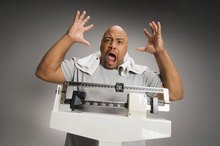The Ideal Calf to Ankle Body Proportions
Trying to get your body to conform to a particular shape can be a losing proposition as body ideals change from decade to decade. Contrast the curvy 1950s with the skinny 1960s, and you can see how the body image that was ideal before suddenly fell out of fashion. Ideal body proportions are usually considered part of the world of trends and fashion. In bodybuilding, however, the measurements needed to get a body like that of Steve Reeves, a champion bodybuilder from the 1940s and 1950s, are set at a certain proportion 6.
Considerations
There’s no exact, ideal medical proportion for calves and ankles in general. If there were, most of the world probably wouldn’t meet it because everyone is a different shape and has different genetics. A 2009 article in "The Wall Street Journal” notes an average circumference for women’s ankles is 11 inches, but that is just an average and not an official ideal 5. Typically, the leg tapers down from the calf to the ankle. The undetermined range that looks "normal" may be easily manipulated by fads and current trends.
- There’s no exact, ideal medical proportion for calves and ankles in general.
- A 2009 article in "The Wall Street Journal” notes an average circumference for women’s ankles is 11 inches, but that is just an average and not an official ideal 5.
Cankles
The Ideal Body Fat Percentage
Learn More
One condition that initially seems to point to an idealized look for calves and ankles is the “cankle,” or an ankle that is just as thick or only a little thinner than the calf. Sometimes these cankles are due to medical conditions like excessive water retention, but sometimes they are merely thick ankles. Nothing medically separates thick ankles from “cankles.” The "Wall Street Journal" article notes the term "cankles" wasn't very common until 2001, when it was mentioned in a movie.
Medical Swelling
Ankles can end up swollen over the long term due to medical conditions like kidney disease, heat edema, bad sprains and surgery. In these cases, where it may be a while before the ankle returns to normal or where it’s possible that it will remain swollen indefinitely, you need to speak to your doctor to determine the possible outcome, rather than wondering about ideal proportions. Any noticeable change in the width of an ankle and calf that is not due to something already diagnosed must be checked out medically.
- Ankles can end up swollen over the long term due to medical conditions like kidney disease, heat edema, bad sprains and surgery.
- In these cases, where it may be a while before the ankle returns to normal or where it’s possible that it will remain swollen indefinitely, you need to speak to your doctor to determine the possible outcome, rather than wondering about ideal proportions.
Bodybuilding
How to Tell If Your Legs Are Mostly Muscle or Fat
Learn More
In the 1940s and 1950s, bodybuilder Steve Reeves had a physique that Bodybuilding.com says was considered flawless, and over the years bodybuilders have attempted to imitate this look. Reeves' proportions were measured, and those trying to attain his shape would have to match a height-weight pairing and six different "physique ratios." One of these is the ankle-to-calf ratio; the calf should be 192 percent of the size of the ankle.
Related Articles
References
- Rothman Institute: Foot & Ankle
- American Academy of Orthopaedic Surgeons: Sprained Ankle
- MedlinePlus: Foot, Leg, and Ankle Swelling
- The Guardian: The Truth About Cankles
- The Wall Street Journal: For the Body-Conscious, It's Now the Ankle That Rankles
- Bodybuilding.com: Know Your Measurements for Bodybuilding Success
- Leclère FM, Moreno-Moraga J, Mordon S, Servell P, Unglaub F, Kolb F, Rimareix F, Trelles MA. "Laser-Assisted Lipolysis for Cankle Remodelling: A Prospective Study in 30 Patients." Lasers in Medical Science January 29, 2014. doi: 10.1007/s10103-013-1279-4
- Medline Plus. Foot, Leg, and Ankle Swelling National Library of Medicine.
Writer Bio
Suzanne S. Wiley is an editor and writer in Southern California. She has been editing since 1989 and began writing in 2009. Wiley received her master's degree from the University of Texas and her work appears on various websites.








